Complexes with Atomic Gold Ions: Efficient Bis-Ligand Formation
Abstract
:1. Introduction
2. Results and Discussion
2.1. Cations
2.2. Anions
3. Materials and Methods
3.1. Experimental Methods
3.2. Computational Methods
4. Conclusions
Author Contributions
Funding
Institutional Review Board Statement
Informed Consent Statement
Data Availability Statement
Conflicts of Interest
Sample Availability
References
- Hutchings, G.J.; Brust, M.; Schmidbaur, H. Gold-an introductory perspective. Chem. Soc. Rev. 2008, 37, 1759–1765. [Google Scholar] [CrossRef] [PubMed]
- Pyykkö, P. Relativistic effects in chemistry: More common than you thought. In Annual Review of Physical Chemistry; Johnson, M.A., Martinez, T.J., Eds.; Annual Reviews: Palo Alto, CA, USA, 2012; Volume 63, pp. 45–64. [Google Scholar]
- Dyubko, S.F.; Efremov, V.A.; Gerasimov, V.G.; MacAdam, K.B. Millimetre-wave spectroscopy of Au I Rydberg states: S, P and D terms. J. Phys. B-At. Mol. Opt. Phys. 2005, 38, 1107–1118. [Google Scholar] [CrossRef]
- Hotop, H.; Lineberger, W.C. Dye-laser photodetachment studies of Au−, Pt−, PtN−, and Ag−. J. Chem. Phys. 1973, 58, 2379–2387. [Google Scholar] [CrossRef]
- Kapur, S.; Müller, E.W. Metal-neon compound ions in slow field evaporation. Surf. Sci. 1977, 62, 610–620. [Google Scholar] [CrossRef]
- Pyykkö, P. Predicted Chemical Bonds between Rare Gases and Au+. J. Am. Chem. Soc. 1995, 117, 2067–2070. [Google Scholar] [CrossRef]
- Schröder, D.; Schwarz, H.; Hrusak, J.; Pyykkö, P. Cationic gold(I) complexes of xenon and of ligands containing the donor atoms oxygen, nitrogen, phosphorus, and sulfur. Inorg. Chem. 1998, 37, 624–632. [Google Scholar] [CrossRef]
- Schröder, D.; Hrusak, J.; Hertwig, R.H.; Koch, W.; Schwerdtfeger, P.; Schwarz, H. Experimental and theoretical studies of Gold(I) complexes Au(L)+ (L = H2O, CO, NH3, C2H4, C3H6, C4H6, C6H6, C6F6). Organometallics 1995, 14, 312–316. [Google Scholar] [CrossRef]
- Gonzalez-Lezana, T.; Echt, O.; Gatchell, M.; Bartolomei, M.; Campos-Martinez, J.; Scheier, P. Solvation of ions in helium. Int. Rev. Phys. Chem. 2020, 39, 465–516. [Google Scholar] [CrossRef]
- Martini, P.; Kranabetter, L.; Goulart, M.; Kuhn, M.; Gatchell, M.; Böhme, D.K.; Scheier, P. Formation of positive and negative clusters of gold atoms inside helium nanodroplets close to zero K. Int. J. Mass Spectrom. 2018, 434, 136–141. [Google Scholar] [CrossRef]
- Gatchell, M.; Goulart, M.; Kranabetter, L.; Kuhn, M.; Martini, P.; Rasul, B.; Scheier, P. Complexes of gold and imidazole formed in helium nanodroplets. Phys. Chem. Chem. Phys. 2018, 20, 7739–7745. [Google Scholar] [CrossRef] [Green Version]
- Goulart, M.; Gatchell, M.; Kranabetter, L.; Kuhn, M.; Martini, P.; Gitzl, N.; Rainer, M.; Postler, J.; Scheier, P.; Ellis, A.M. The adsorption of helium atoms on small cationic gold clusters. Phys. Chem. Chem. Phys. 2018, 20, 9554–9560. [Google Scholar] [CrossRef] [PubMed]
- Goulart, M.; Kuhn, M.; Martini, P.; Chen, L.; Hagelberg, F.; Kaiser, A.; Scheier, P.; Ellis, A.M. Highly stable [C60AuC60]+/− dumbbells. J. Phys. Chem. Lett. 2018, 9, 2703–2706. [Google Scholar] [CrossRef] [PubMed]
- Martini, P.; Kranabetter, L.; Goulart, M.; Rasul, B.; Gatchell, M.; Scheier, P.; Echt, O. Atomic Gold ions clustered with noble gases: Helium, Neon, Argon, Krypton, and Xenon. J. Phys. Chem. A 2019, 123, 9505–9513. [Google Scholar] [CrossRef] [PubMed]
- Tiefenthaler, L.; Ameixa, J.; Martini, P.; Albertini, S.; Ballauf, L.; Zankl, M.; Goulart, M.; Laimer, F.; von Haeften, K.; Zappa, F.; et al. An intense source for cold cluster ions of a specific composition. Rev. Sci. Instrum. 2020, 91, 11. [Google Scholar] [CrossRef]
- Lundberg, L.; Martini, P.; Goulart, M.; Gatchell, M.; Böhme, D.K.; Scheier, P. Hydrogenated gold clusters from helium nanodroplets: Displacement of H2 by H2O. Eur. Phys. J. D 2020, 74, 6. [Google Scholar] [CrossRef]
- Yang, S.F.; Wu, H.; Luo, Q.Q.; Al Hindawi, A.M.; Sitorus, B.; Ellis, A.M.; Yang, J.L. Ion-molecule reactions catalyzed by a single gold atom. Chem. Sci. 2020, 11, 8502–8505. [Google Scholar] [CrossRef]
- Feng, C.; Latimer, E.; Spence, D.; Al Hindawi, A.; Bullen, S.; Boatwright, A.; Ellis, A.M.; Yang, S.F. Formation of Au and tetrapyridyl porphyrin complexes in superfluid helium. Phys. Chem. Chem. Phys. 2015, 17, 16699–16704. [Google Scholar] [CrossRef] [Green Version]
- Latimer, E.; Spence, D.; Feng, C.; Boatwright, A.; Ellis, A.M.; Yang, S.F. Preparation of ultrathin nanowires using superfluid helium droplets. Nano Lett. 2014, 14, 2902–2906. [Google Scholar] [CrossRef] [Green Version]
- Boatwright, A.; Feng, C.; Spence, D.; Latimer, E.; Binns, C.; Ellis, A.M.; Yang, S.F. Helium droplets: A new route to nanoparticles. Faraday Discuss. 2013, 162, 113–124. [Google Scholar] [CrossRef]
- Thaler, P.; Volk, A.; Knez, D.; Lackner, F.; Haberfehlner, G.; Steurer, J.; Schnedlitz, M.; Ernst, W.E. Synthesis of nanoparticles in helium droplets-A characterization comparing mass-spectra and electron microscopy data. J. Chem. Phys. 2015, 143, 10. [Google Scholar] [CrossRef] [Green Version]
- Haberfehlner, G.; Thaler, P.; Knez, D.; Volk, A.; Hofer, F.; Ernst, W.E.; Kothleitner, G. Formation of bimetallic clusters in superfluid helium nanodroplets analysed by atomic resolution electron tomography. Nat. Commun. 2015, 6, 6. [Google Scholar] [CrossRef] [Green Version]
- Volk, A.; Thaler, P.; Knez, D.; Hauser, A.W.; Steurer, J.; Grogger, W.; Hofer, F.; Ernst, W.E. The impact of doping rates on the morphologies of silver and gold nanowires grown in helium nanodroplets. Phys. Chem. Chem. Phys. 2016, 18, 1451–1459. [Google Scholar] [CrossRef] [Green Version]
- Schnedlitz, M.; Lasserus, M.; Knez, D.; Hauser, A.W.; Hofer, F.; Ernst, W.E. Thermally induced breakup of metallic nanowires: Experiment and theory. Phys. Chem. Chem. Phys. 2017, 19, 9402–9408. [Google Scholar] [CrossRef] [Green Version]
- Schnedlitz, M.; Lasserus, M.; Meyer, R.; Knez, D.; Hofer, F.; Ernst, W.E.; Hauser, A.W. Stability of core-shell nanoparticles for catalysis at elevated temperatures: Structural inversion in the Ni-Au system observed at atomic resolution. Chem. Mat. 2018, 30, 1113–1120. [Google Scholar] [CrossRef]
- Dong, Y.; Springborg, M. Unbiased determination of structural and electronic properties of gold clusters with up to 58 atoms. J. Phys. Chem. C 2007, 111, 12528–12535. [Google Scholar] [CrossRef]
- Mauracher, A.; Echt, O.; Ellis, A.M.; Yang, S.; Bohme, D.K.; Postler, J.; Kaiser, A.; Denifl, S.; Scheier, P. Cold physics and chemistry: Collisions, ionization and reactions inside helium nanodroplets close to zero K. Phys. Rep.-Rev. Sec. Phys. Lett. 2018, 751, 1–90. [Google Scholar] [CrossRef] [Green Version]
- Katakuse, I.; Ichihara, T.; Fujita, Y.; Matsuo, T.; Sakurai, T.; Matsuda, H. Mass distributions of copper, silver and gold clusters and electronic shell structure. Int. J. Mass Spectrom. Ion Process. 1985, 67, 229–236. [Google Scholar] [CrossRef]
- Collings, B.A.; Athanassenas, K.; Lacombe, D.; Rayner, D.M.; Hackett, P.A. Optical absorption spectra of Au7, Au9, Au11, and Au13, and their cations: Gold clusters with 6, 7, 8, 9, 10, 11, 12, and 13 s-electrons. J. Chem. Phys. 1994, 101, 3506–3513. [Google Scholar] [CrossRef]
- Märk, T.D.; Scheier, P.; Leiter, K.; Ritter, W.; Stephan, K.; Stamatovic, A. Unimolecular decay of metastable Ar cluster ions. Evolution of magic numbers in Ar cluster mass spectra. Int. J. Mass Spectrom. 1986, 74, 281–301. [Google Scholar] [CrossRef]
- Callicoatt, B.E.; Förde, K.; Ruchti, T.; Jung, L.L.; Janda, K.C.; Halberstadt, N. Capture and ionization of argon within liquid helium droplets. J. Chem. Phys. 1998, 108, 9371–9382. [Google Scholar] [CrossRef]
- Ellis, A.M.; Yang, S.F. Model for the charge-transfer probability in helium nanodroplets following electron-impact ionization. Phys. Rev. A 2007, 76, 8. [Google Scholar] [CrossRef] [Green Version]
- Halberstadt, N.; Bonhommeau, D.A. Fragmentation dynamics of Ar4He1000 upon electron impact ionization: Competition between ion ejection and trapping. J. Chem. Phys. 2020, 152, 16. [Google Scholar] [CrossRef]
- Albertini, S.; Gruber, E.; Zappa, F.; Krasnokutskiy, S.; Laimer, F.; Scheier, P. Chemistry and physics of dopants embedded in helium droplets. Mass Spectrom. Rev. 2021. [Google Scholar] [CrossRef]
- Albertini, S.; Bergmeister, S.; Laimer, F.; Martini, P.; Gruber, E.; Zappa, F.; Ončák, M.; Scheier, P.; Echt, O. SF6+: Stabilizing transient ions in helium nanodroplets. J. Phys. Chem. Lett. 2021, 12, 4112–4117. [Google Scholar] [CrossRef]
- Tiefenthaler, L.; Kollotzek, S.; Ellis, A.M.; Scheier, P.; Echt, O. Proton transfer at subkelvin temperatures. Phys. Chem. Chem. Phys. 2020, 22, 28165–28172. [Google Scholar] [CrossRef]
- Albertini, S.; Hechenberger, F.; Kollotzek, S.; Tiefenthaler, L.; Martini, P.; Kuhn, M.; Menzel, A.; Al Maalouf, E.J.; Schöbel, H.; Mahmoodi-Darian, M.; et al. Phosphorus cluster cations formed in doped helium nanodroplets are different. Int. J. Mass Spectrom. 2021, 459, 6. [Google Scholar] [CrossRef]
- Bartl, P.; Leidlmair, C.; Denifl, S.; Scheier, P.; Echt, O. On the size and structure of helium snowballs formed around charged atoms and clusters of noble gases. J. Phys. Chem. A 2014, 118, 8050–8059. [Google Scholar] [CrossRef]
- Mendizabal, F.; Miranda-Rojas, S.; Castro-Latorre, P. Quantum chemistry simulation of the electronic properties in Au(NH3)(2) NO3 and Au(NCH)(2) AuCl4 extended unsupported complexes. Mol. Simul. 2020, 46, 521–529. [Google Scholar] [CrossRef]
- Yao, W.Z.; Li, D.Z.; Li, S.D. Bridging Gold: B-Au-B three-center-two-electron bonds in electron-deficient B2Aun-/0 (n = 1, 3, 5) and mixed analogues. J. Comput. Chem. 2011, 32, 218–225. [Google Scholar] [CrossRef]
- Wang, X.B.; Wang, Y.L.; Yang, J.; Xing, X.P.; Li, J.; Wang, L.S. Evidence of significant covalent bonding in Au(CN)2−. J. Am. Chem. Soc. 2009, 131, 16368–16370. [Google Scholar] [CrossRef]
- Xiong, X.G.; Wang, Y.L.; Xu, C.Q.; Qiu, Y.H.; Wang, L.S.; Li, J. On the gold-ligand covalency in linear [AuX2]− complexes. Dalton Trans. 2015, 44, 5535–5546. [Google Scholar] [CrossRef] [PubMed]
- Li, X.Y.; Cao, X. Ab initio study of MXen+ (M = Cu, Ag, and Au; n = 1,2). Phys. Rev. A 2008, 77, 5. [Google Scholar] [CrossRef]
- Goetzfried, S.K.; Gallati, C.M.; Cziferszky, M.; Talmazan, R.A.; Wurst, K.; Liedl, K.R.; Podewitz, M.; Gust, R. N-Heterocyclic carbene Gold(I) complexes: Mechanism of the ligand scrambling reaction and their oxidation to Gold(III) in aqueous solutions. Inorg. Chem. 2020, 59, 15312–15323. [Google Scholar] [CrossRef] [PubMed]
- Grabowski, S.J.; Ugalde, J.M.; Andrada, D.M.; Frenking, G. Comparison of hydrogen and Gold bonding in [XHX]−, [XAuX]−, and isoelectronic [NgHNg]+, [NgAuNg]+ (X = Halogen, Ng = Noble Gas). Chem. Eur. J. 2016, 22, 11317–11328. [Google Scholar] [CrossRef]
- Song, X.D.; Zhao, Y.F.; Zhang, G.H.; Zhang, P.X. Theoretical study on structures, binding energies and vibrational spectra of M+(H2O)2Ar (M = Cu, Ag, Au). Comput. Theor. Chem. 2011, 963, 290–293. [Google Scholar] [CrossRef]
- Li, X.Y.; Cao, X.; Zhao, Y.F. Structure and stability of AuXenZ (n = 1–3, Z = −1, 0, +1) clusters. Theor. Chem. Acc. 2009, 123, 469–475. [Google Scholar] [CrossRef]
- Wang, L.S. Covalent gold. Phys. Chem. Chem. Phys. 2010, 12, 8694–8705. [Google Scholar] [CrossRef]
- Swart, M. Metal-ligand bonding in metallocenes: Differentiation between spin state, electrostatic and covalent bonding. Inorg. Chim. Acta 2007, 360, 179–189. [Google Scholar] [CrossRef]
- Masubuchi, T.; Nakajima, A. Electronic properties of transition metal-benzene sandwich clusters. In Theoretical Chemistry for Advanced Nanomaterials: Functional Analysis by Computation and Experiment; Onishi, T., Ed.; Springer Singapore: Singapore, 2020; pp. 313–349. [Google Scholar]
- Lundberg, L.; Martini, P.; Goulart, M.; Gatchell, M.; Böhme, D.K.; Scheier, P. Hydrogenated Gold clusters from helium nanodroplets: Cluster ionization and affinities for protons and hydrogen molecules. J. Am. Soc. Mass Spectrom. 2019, 30, 1906–1913. [Google Scholar] [CrossRef]
- Cox, D.M.; Brickman, R.; Creegan, K.; Kaldor, A. Gold clusters: Reactions and deuterium uptake. Z. Phys. D Atoms Mol. Clust. 1991, 19, 353–355. [Google Scholar] [CrossRef]
- Koszinowski, K.; Schröder, D.; Schwarz, H. Additivity effects in the reactivities of bimetallic cluster ions PtmAun+. ChemPhysChem 2003, 4, 1233–1237. [Google Scholar] [CrossRef]
- Yoon, B.; Häkkinen, H.; Landman, U. Interaction of O2 with gold clusters: Molecular and dissociative adsorption. J. Phys. Chem. A 2003, 107, 4066–4071. [Google Scholar] [CrossRef] [Green Version]
- Tachikawa, H. Full dimensional ab initio direct dynamics calculations of the ionization of H2 clusters (H2)n (n = 3, 4 and 6). Phys. Chem. Chem. Phys. 2000, 2, 4702–4707. [Google Scholar] [CrossRef]
- Crosby, D.A.; Zorn, J.C. Dipole polarizability of 23S1 and 21S1 metastable helium measured by electric deflection time-of-flight method. Phys. Rev. A 1977, 16, 488–491. [Google Scholar] [CrossRef]
- Antoine, R.; Dugourd, P.; Rayane, D.; Benichou, E.; Broyer, M.; Chandezon, F.; Guet, C. Direct measurement of the electric polarizability of isolated C60 molecules. J. Chem. Phys. 1999, 110, 9771–9772. [Google Scholar] [CrossRef]
- Mauracher, A.; Daxner, M.; Postler, J.; Huber, S.E.; Denifl, S.; Scheier, P.; Toennies, J.P. Detection of negative charge carriers in superfluid helium droplets: The metastable anions He*− and He2*−. J. Phys. Chem. Lett. 2014, 5, 2444–2449. [Google Scholar] [CrossRef]
- Renzler, M.; Daxner, M.; Weinberger, N.; Denifl, S.; Scheier, P.; Echt, O. On subthreshold ionization of helium droplets, ejection of He+, and the role of anions. Phys. Chem. Chem. Phys. 2014, 16, 22466–22470. [Google Scholar] [CrossRef] [Green Version]
- Denifl, S.; Zappa, F.; Mähr, I.; Lecointre, J.; Probst, M.; Märk, T.D.; Scheier, P. Mass spectrometric investigation of anions formed upon free electron attachment to nucleobase molecules and clusters embedded in superfluid helium droplets. Phys. Rev. Lett. 2006, 97, 4. [Google Scholar] [CrossRef]
- Zappa, F.; Denifl, S.; Mähr, I.; Bacher, A.; Echt, O.; Märk, T.D.; Scheier, P. Ultracold water cluster anions. J. Am. Chem. Soc. 2008, 130, 5573–5578. [Google Scholar] [CrossRef]
- Mauracher, A.; Daxner, M.; Huber, S.E.; Postler, J.; Renzler, M.; Denifl, S.; Scheier, P.; Ellis, A.M. Formation of dianions in helium nanodroplets. Angew. Chem. Int. Edit. 2014, 53, 13794–13797. [Google Scholar] [CrossRef]
- Martini, P.; Goulart, M.; Kranabetter, L.; Gitzl, N.; Rasul, B.; Scheier, P.; Echt, O. Charged clusters of C60 and Au or Cu: Evidence for stable sizes and specific dissociation channels. J. Phys. Chem. A 2019, 123, 4599–4608. [Google Scholar] [CrossRef] [PubMed] [Green Version]
- Schöbel, H.; Bartl, P.; Leidlmair, C.; Denifl, S.; Echt, O.; Märk, T.D.; Scheier, P. High-resolution mass spectrometric study of pure helium droplets, and droplets doped with krypton. Eur. Phys. J. D 2011, 63, 209–214. [Google Scholar] [CrossRef]
- Gomez, L.F.; Loginov, E.; Sliter, R.; Vilesov, A.F. Sizes of large He droplets. J. Chem. Phys. 2011, 135, 9. [Google Scholar] [CrossRef] [PubMed]
- Laimer, F.; Zappa, F.; Scheier, P.; Gatchell, M. Multiply charged helium droplet anions. Chem. Eur. J. 2021. [Google Scholar] [CrossRef] [PubMed]
- Ralser, S.; Postler, J.; Harnisch, M.; Ellis, A.M.; Scheier, P. Extracting cluster distributions from mass spectra: Isotope Fit. Int. J. Mass Spectrom. 2015, 379, 194–199. [Google Scholar] [CrossRef] [PubMed] [Green Version]
- Frisch, M.J.; Trucks, G.W.; Schlegel, H.B.; Scuseria, G.E.; Robb, M.A.; Cheeseman, J.R.; Scalmani, G.; Barone, V.; Petersson, G.A.; Nakatsuji, H.; et al. Gaussian 16 Rev. A.03; Gaussian, Inc.: Wallingford, CT, USA, 2016. [Google Scholar]
- Zhao, Y.; Truhlar, D.G. The M06 suite of density functionals for main group thermochemistry, thermochemical kinetics, noncovalent interactions, excited states, and transition elements: Two new functionals and systematic testing of four M06-class functionals and 12 other functionals. Theor. Chem. Acc. 2008, 120, 215–241. [Google Scholar] [CrossRef] [Green Version]
- Weigend, F. Accurate Coulomb-fitting basis sets for H to Rn. Phys. Chem. Chem. Phys. 2006, 8, 1057–1065. [Google Scholar] [CrossRef]
- Weigend, F.; Ahlrichs, R. Balanced basis sets of split valence, triple zeta valence and quadruple zeta valence quality for H to Rn: Design and assessment of accuracy. Phys. Chem. Chem. Phys. 2005, 7, 3297–3305. [Google Scholar] [CrossRef]
- Grimme, S.; Antony, J.; Ehrlich, S.; Krieg, H. A consistent and accurate ab initio parametrization of density functional dispersion correction (DFT-D) for the 94 elements H-Pu. J. Chem. Phys. 2010, 132, 19. [Google Scholar] [CrossRef] [Green Version]

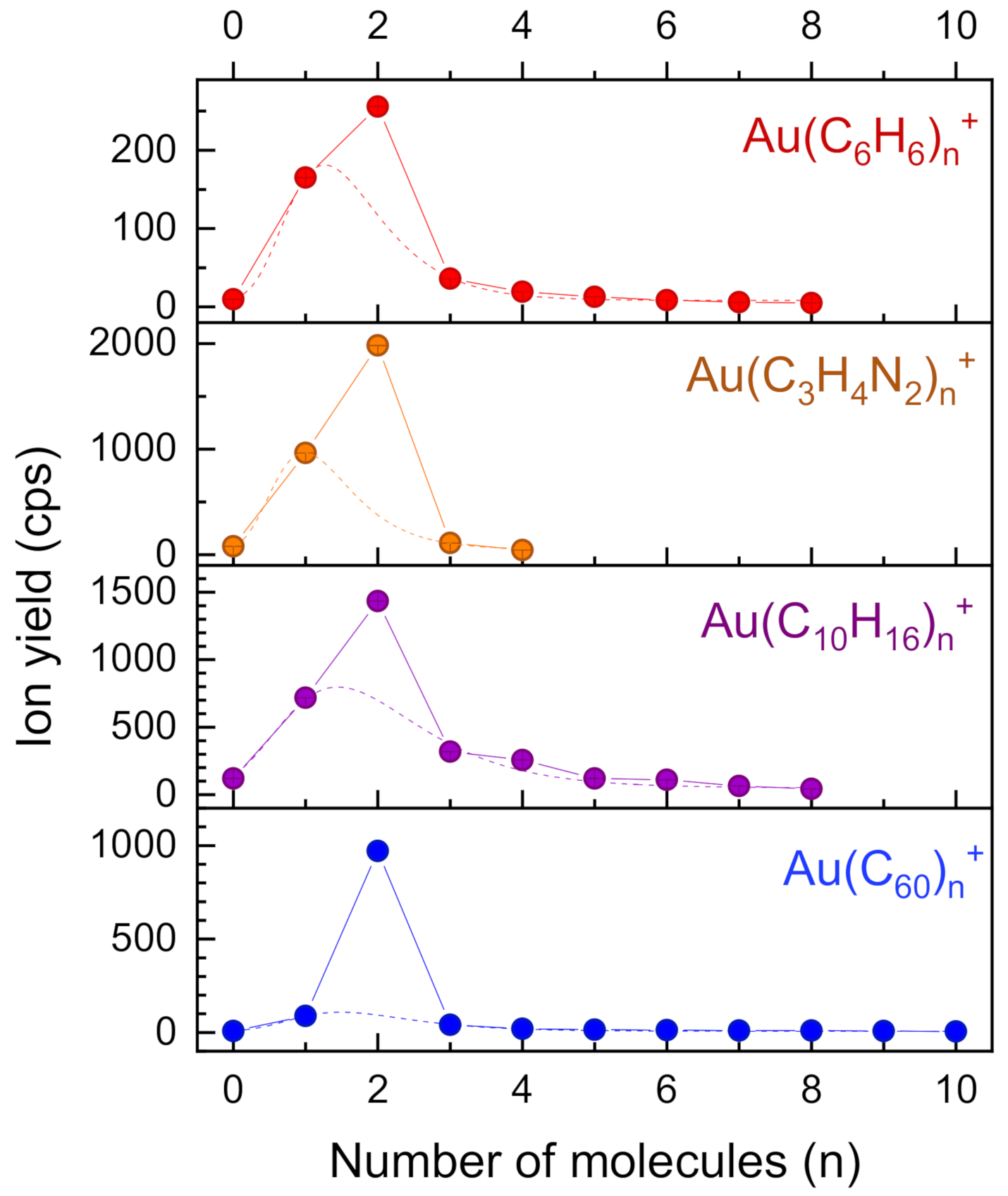
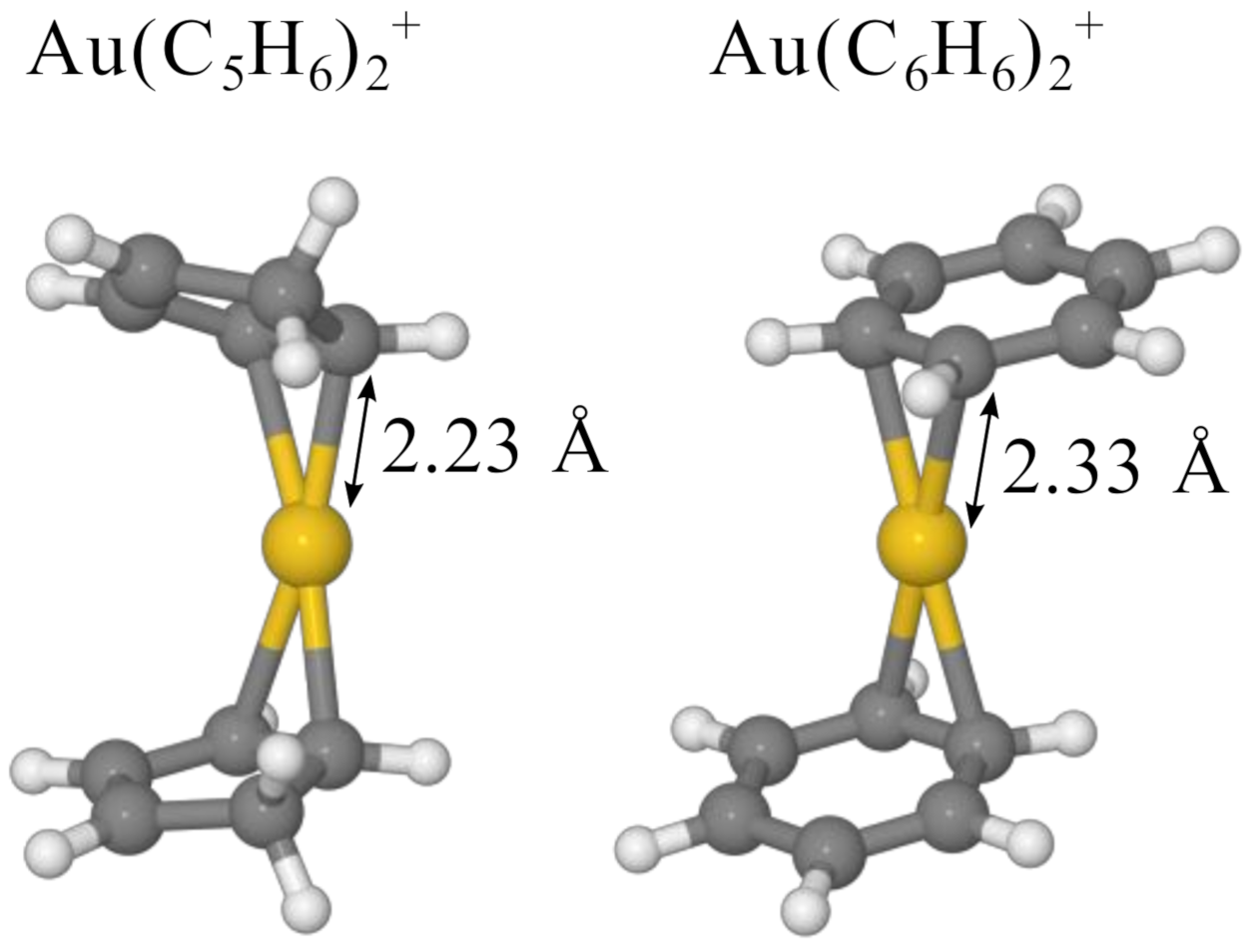
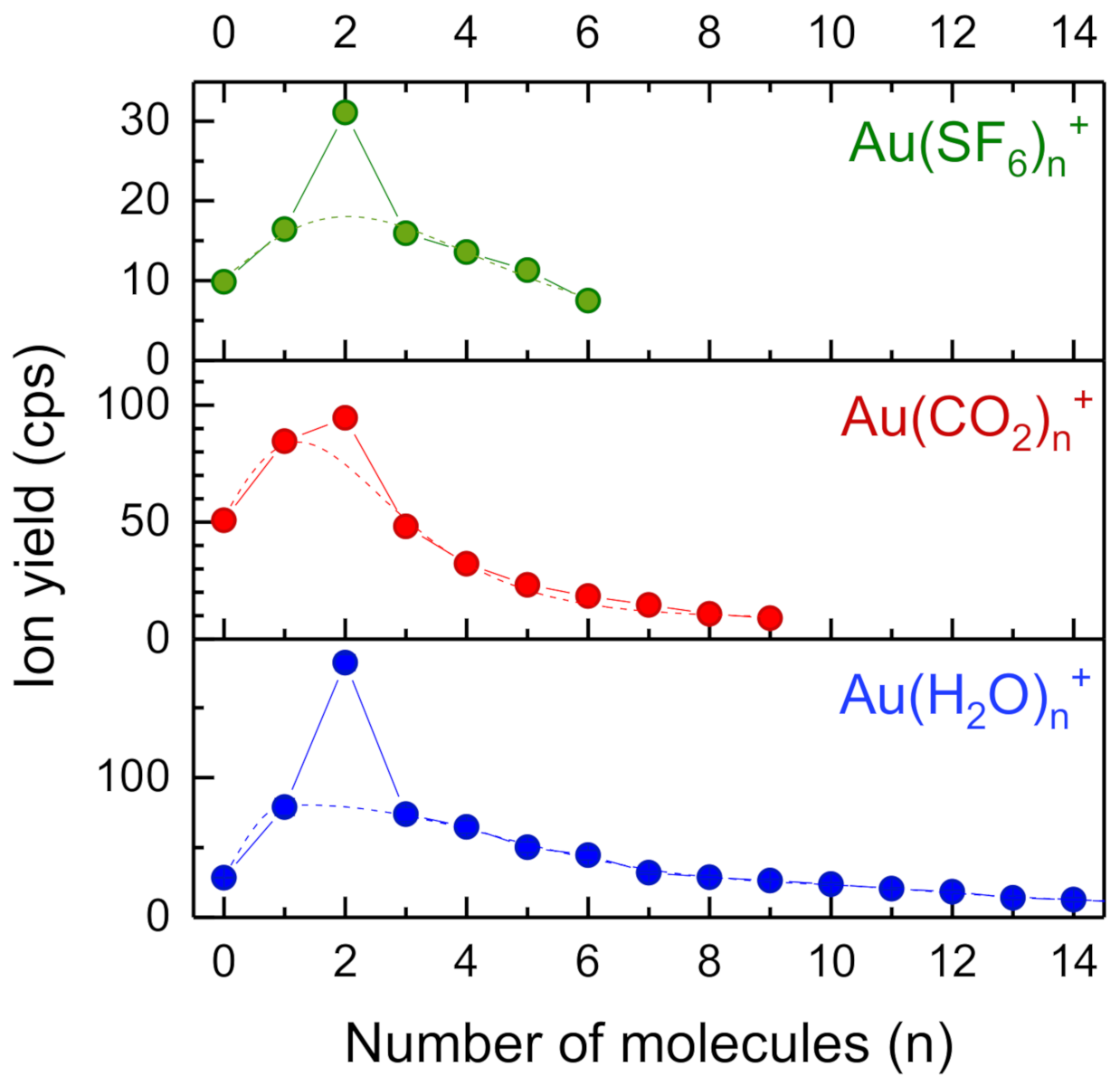
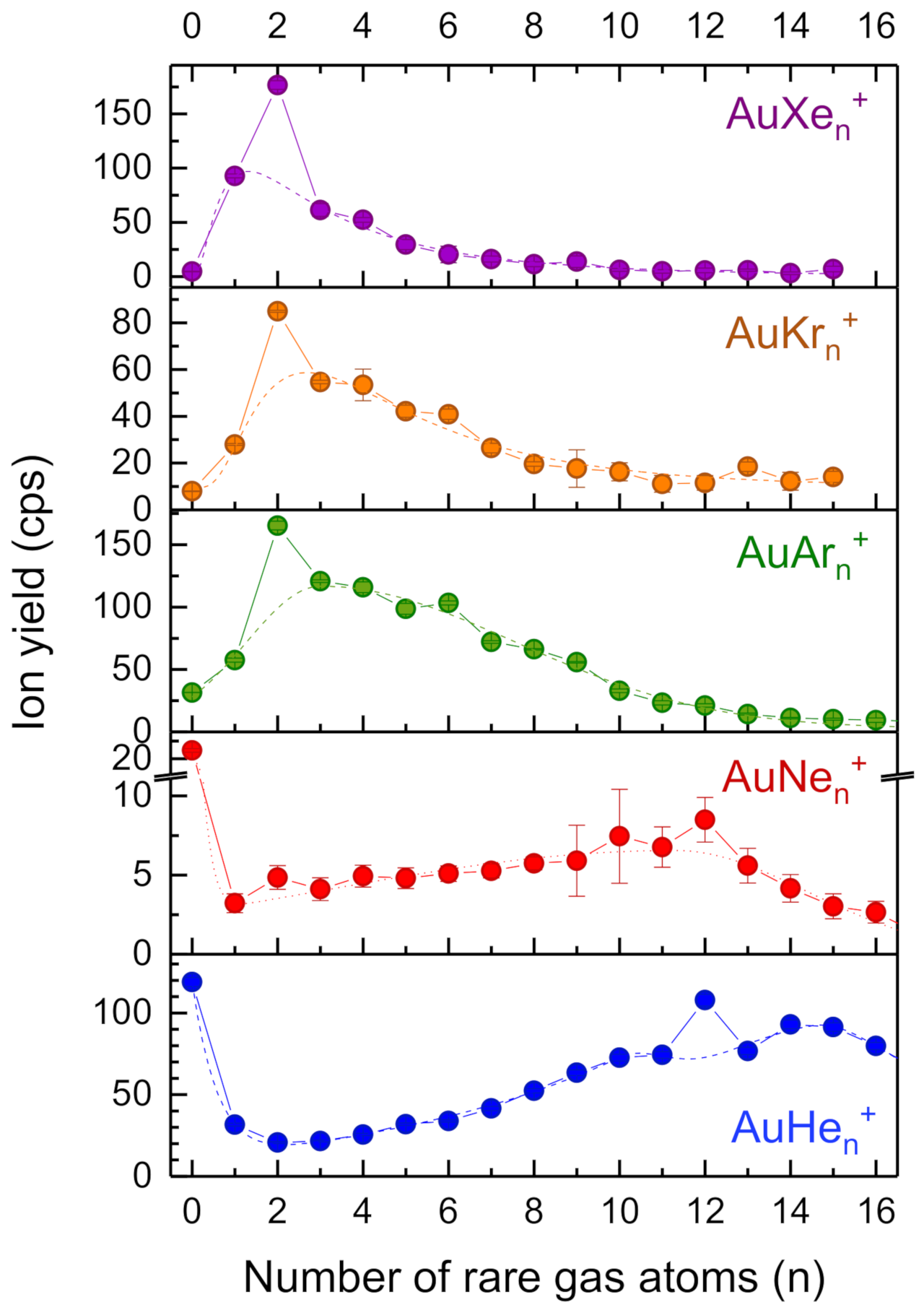

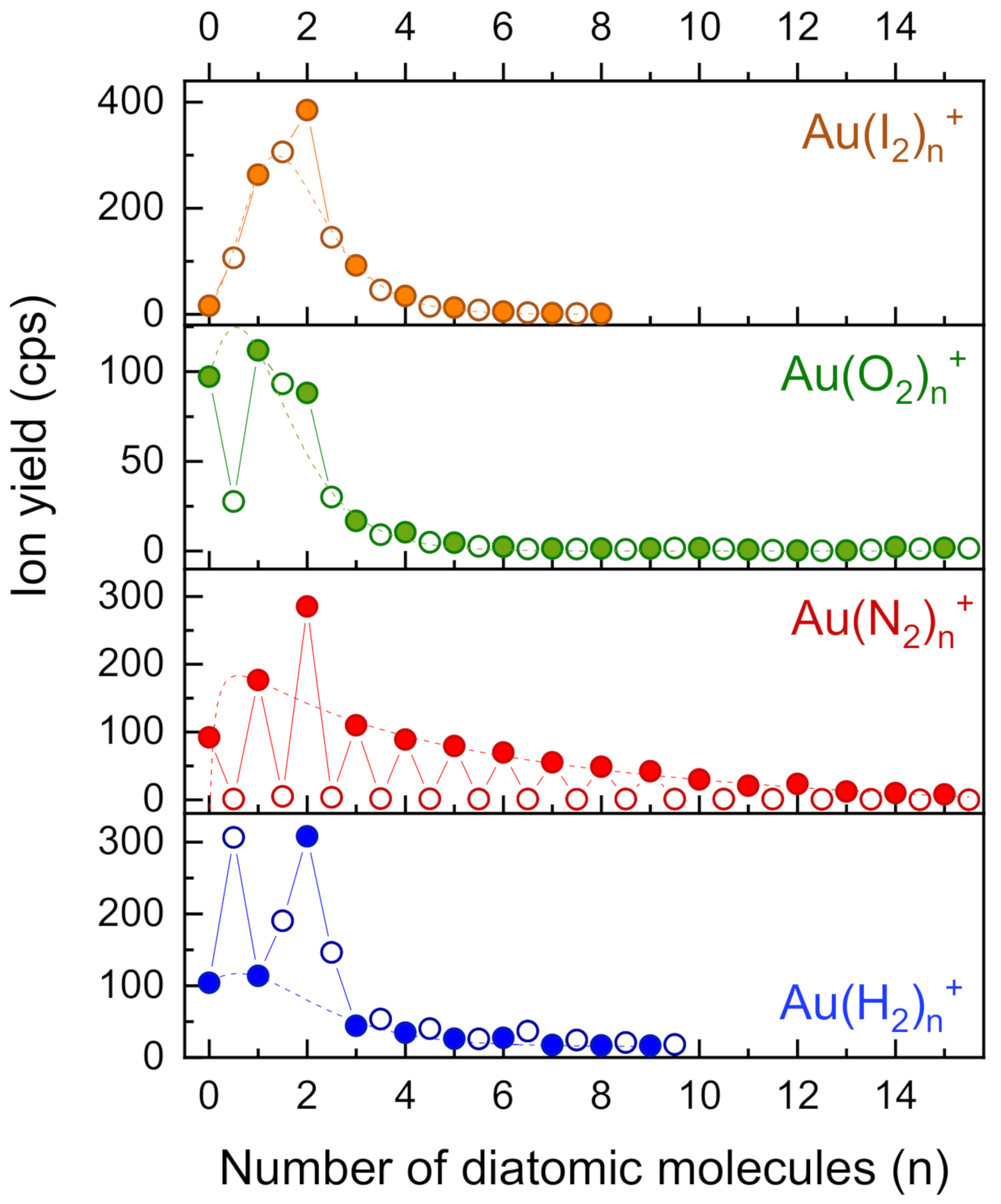
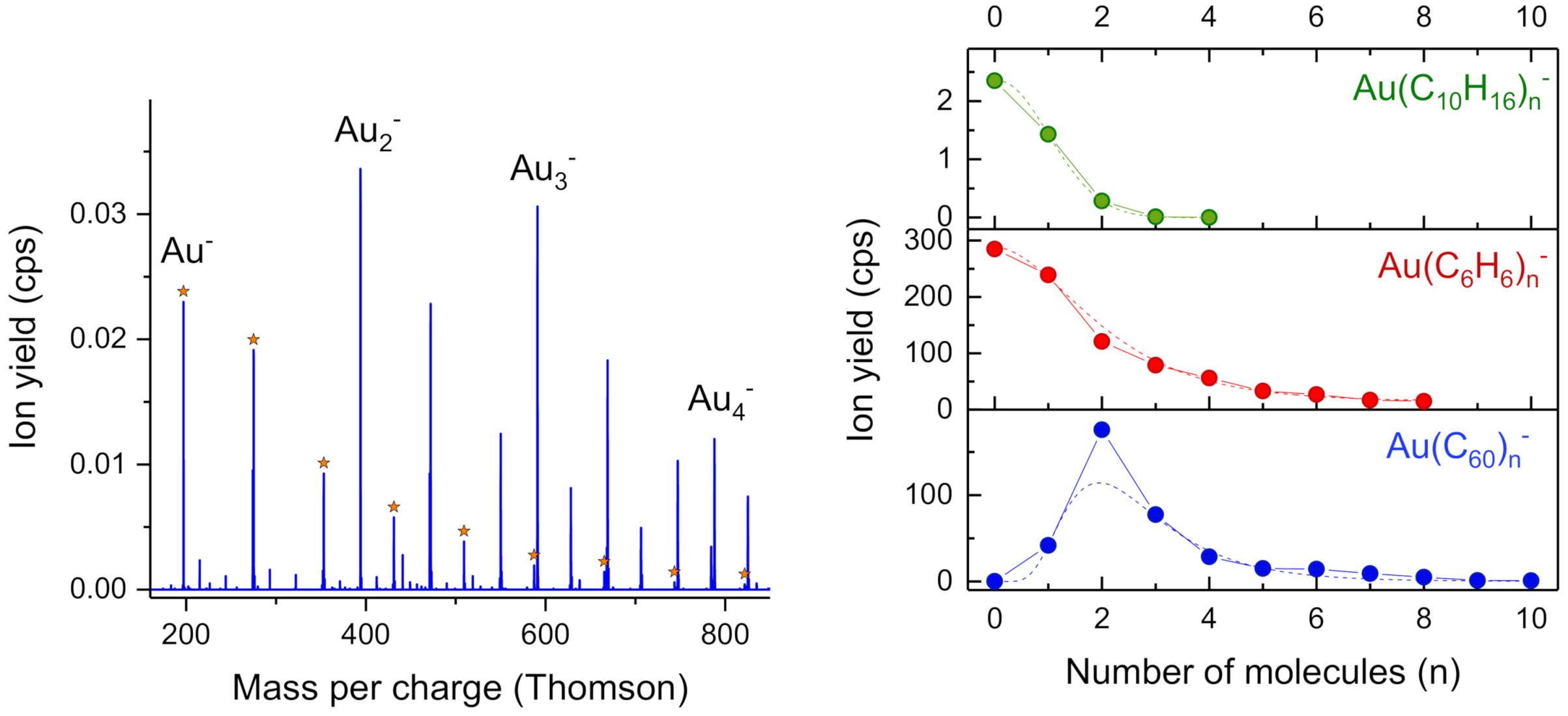
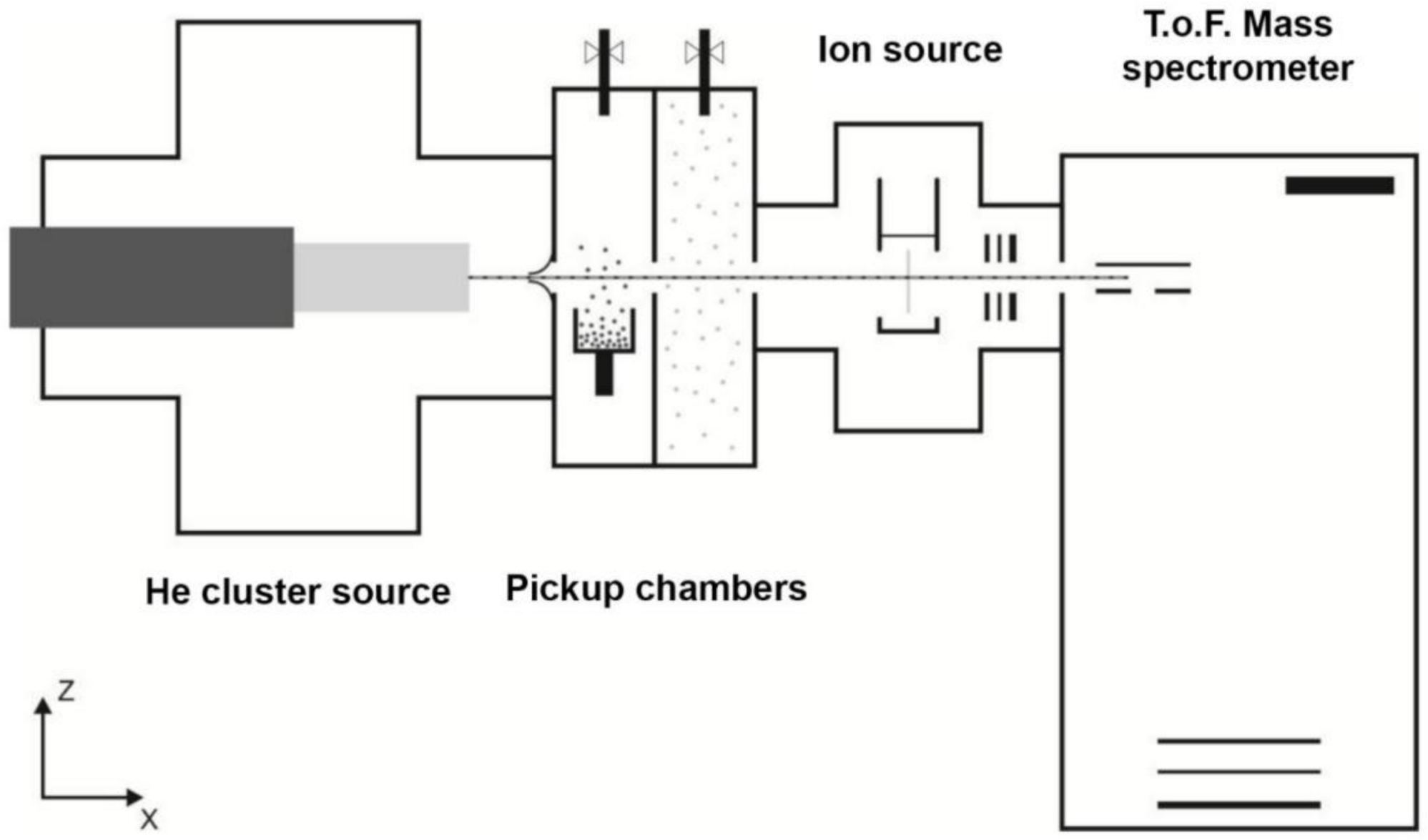
| Ligand | Enhancement Factor of Bis-Ligand |
|---|---|
| Anions | |
| C60 | 1.54 |
| C6H6 | 0.82 |
| C10H16 | 1.02 |
| Cations | |
| H2O | 2.3 |
| CO2 | 1.27 |
| SF6 | 1.72 |
| Xe | 2.03 |
| Kr | 1.57 |
| Ar | 1.66 |
| Ne | 1.37 |
| He | 1.06 |
| P2 | 1.47 |
| I2 | 1.63 |
| O2 | 1.64 |
| N2 | 2.01 |
| H2 | 3.85 |
| C6H6 | 2.19 |
| C10H16 | 2.06 |
| C3H4N2 | 5.29 |
| C60 | 10.44 |
| Ligand | Ratio with Gold | Ratio Pristine | Effect of Gold |
|---|---|---|---|
| C10H12 | 1.46 | 6.73 | 4.61 |
| P2 | 2.59 | 2.31 | 0.89 |
| I2 | 1.29 | 1.37 | 1.06 |
| O2 | 1.93 | 5.16 | 2.67 |
| N2 | 60.03 | 97.6 | 1.63 |
| H2 | 0.82 | 0.05 | 0.06 |
| Ligand | THe (K) | pHe (MPa) | PU | Toven (K) | pPU1 (mPa) | Poven Au (W) | pPU2 (mPa) | Eel (eV) | Iel (µA) |
|---|---|---|---|---|---|---|---|---|---|
| C3H4N2, Imidazole | 9.7 | 2.5 | Gas inlet into oven PU1 | 359 | 1.21 | 118 | 0.34 | 110 | 82 |
| C10H12, di-cyclo-pentadiene | 10 | 3 | Gas inlet into oven PU1 | 0.55 | 144 | 0.28 | 88 | 160 | |
| C6H6 | 9.6 | 2.7 | Gas inlet PU2 | 1.1 | 128 | 2.81 | 93 | 247 | |
| C60 | 9.5 | 2.25 | Oven PU1 | 590 | 0.92 | 106 | 0.29 | 73 | 88 |
| C10H16, adamantane | 9.8 | 2.3 | Gas inlet PU1 | 1 | 100–166 | 70 | 255 | ||
| I2 | 9.3 | 2.1 | Gas inlet PU1 | 6.9 | 144 | 0.22 | 142 | 118 | |
| O2 | 9.4 | 2.5 | Gas inlet PU1 | 1.35 | 120 | 0.47 | 95 | 110 | |
| N2 | 9.7 | 2.6 | Gas inlet PU1 | 1.43 | 120 | 0.48 | 85 | 97 | |
| H2 | 9.5 | 2.6 | Gas inlet PU1 | 1.2 | 120 | 0.49 | 85 | 93 | |
| P2 | 9.6 | 2.4 | from Au oven | 9.4 | 60 | 0.55 | 80 | 33 | |
| Xe | 9.6 | 2.2 | Gas inlet PU1 | 1 | 113 | 0.34 | 63.5 | 117 | |
| Kr | 9.5 | 2.4 | Gas inlet PU1 | 1 | 116 | 0.38 | 91.2 | 101 | |
| Ar | 9.4 | 2.1 | Gas inlet PU1 | 1 | 114 | 0.36 | 52 | 127 | |
| Ne | 9.7 | 2.2 | Gas inlet PU2 | 1 | 114 | 2.2 | 57 | 133 | |
| He | 9.4 | 2.25 | 0.96 | 104 | 0.31 | 55 | 109 | ||
| SF6 | 9.4 | 2.4 | Gas inlet PU1 | 1 | 117 | 0.35 | 115 | 74 | |
| CO2 | 9.7 | 2.5 | Gas inlet PU1 | 1.3 | 120 | 0.41 | 85 | 97 | |
| H2O | 9.4 | 2.1 | Gas inlet PU2 | 0.88 | 189 | - | 90 | 51 |
Publisher’s Note: MDPI stays neutral with regard to jurisdictional claims in published maps and institutional affiliations. |
© 2021 by the authors. Licensee MDPI, Basel, Switzerland. This article is an open access article distributed under the terms and conditions of the Creative Commons Attribution (CC BY) license (https://creativecommons.org/licenses/by/4.0/).
Share and Cite
Duensing, F.; Gruber, E.; Martini, P.; Goulart, M.; Gatchell, M.; Rasul, B.; Echt, O.; Zappa, F.; Mahmoodi-Darian, M.; Scheier, P. Complexes with Atomic Gold Ions: Efficient Bis-Ligand Formation. Molecules 2021, 26, 3484. https://doi.org/10.3390/molecules26123484
Duensing F, Gruber E, Martini P, Goulart M, Gatchell M, Rasul B, Echt O, Zappa F, Mahmoodi-Darian M, Scheier P. Complexes with Atomic Gold Ions: Efficient Bis-Ligand Formation. Molecules. 2021; 26(12):3484. https://doi.org/10.3390/molecules26123484
Chicago/Turabian StyleDuensing, Felix, Elisabeth Gruber, Paul Martini, Marcelo Goulart, Michael Gatchell, Bilal Rasul, Olof Echt, Fabio Zappa, Masoomeh Mahmoodi-Darian, and Paul Scheier. 2021. "Complexes with Atomic Gold Ions: Efficient Bis-Ligand Formation" Molecules 26, no. 12: 3484. https://doi.org/10.3390/molecules26123484






